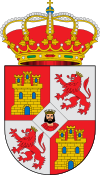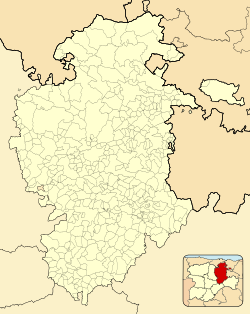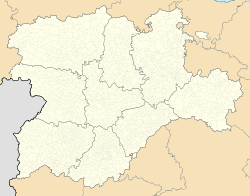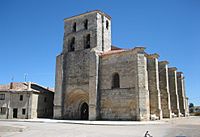Villadiego facts for kids
Quick facts for kids
Villadiego
|
|||
|---|---|---|---|
|
|||
| Country | |||
| Autonomous community | |||
| Province | Burgos | ||
| Comarca | Odra-Pisuerga | ||
| Area | |||
| • Total | 327,96 km2 (12,663 sq mi) | ||
| Elevation | 840 m (2,760 ft) | ||
| Population
(2018)
|
|||
| • Total | 1,527 | ||
| • Density | 4.99/km2 (12.9/sq mi) | ||
| Time zone | UTC+1 (CET) | ||
| • Summer (DST) | UTC+2 (CEST) | ||
| Website | http://www.villadiego.es/ | ||
Villadiego is a town and municipality in Spain. It is located in the western part of the Province of Burgos. This province is in the region of Castile and León.
Villadiego is the main town of the Odra-Pisuerga area. It is about 39 kilometers (24 miles) away from Burgos, the capital city of the province.
The town was started by Count Diego Porcelos in the 800s. Villadiego has many old buildings, especially around its main square. The main square is called Plaza Porticada and is known for its traditional look.
Contents
Location of Villadiego
Villadiego is about 38 kilometers (23.6 miles) from Burgos. It is part of the Odra-Pisuerga region. The municipality covers an area of 327.96 square kilometers (126.6 square miles).
It is the largest municipality in the Burgos province. Villadiego is in the northwest of the province. It includes areas like Humada and Basconcillos del Tozo to the north. To the east is Huérmeces.
To the south are towns like Las Hormazas and Villegas. Sotresgudo is to the west. The municipality also includes three historic areas. These are Amaya, Los Ordejones, and the Treviño region.
Population of Villadiego
In 2013, the municipality of Villadiego had 1,637 people living there. There were 893 men and 744 women.
It is important to know that many more people live in Villadiego for part of the year. These people are not always counted in the official census. Many moved to bigger cities for work in the past. After they retire, they often come back to their hometowns. Also, many homes in Villadiego are only used on weekends.
History of Villadiego
Villadiego was founded in the 9th century. It was started by a person named Don Diego Rodriguez Porcelos. He was also known as the Lord of Amaya.
During the Middle Ages, Villadiego was home to a Jewish community. This community lived there until 1492. In that year, Jewish people were asked to leave Spain.
A famous historian named Enrique Flórez was born in Villadiego. He lived in the 1700s. He wrote an important book called Sacred Spain.
In 1787, a census (population count) was taken. It showed that Villadiego was an important town. It had its own mayor and court. The Duke of Frias was in charge of the area. Villadiego was the main town for many smaller villages and areas around it.
Places to See in Villadiego
The entire town of Villadiego was declared a historical site on December 29, 1994. This means it has many important old buildings and areas.
Old Buildings
- Main Square of Villadiego: This square has old arcaded buildings. These are buildings with arches that form a covered walkway.
- Statue of Fray Enrique Flórez: In the center of the Main Square, there is a statue of the historian Enrique Flórez. It was made in 1906 by Aniceto Marinas.
- Velasco's Palace: This is a palace from the 1500s.
- Old Houses: There are also historic houses like Porras, Varona, Bustillo, Santa Cruz, and Borja houses.
- Artesian Well: This is a special type of well where water flows up naturally.
- Bullring: The town's bullring was built in 1957.
Churches and Convents
- Church of San Lorenzo: This church was built between the 1300s and 1400s.
- St. Mary's Church: This is a Gothic-style building from the 1500s.
- Convent of San Miguel de los Angeles: This convent also has a Gothic church built in the 1500s.
- Christ Hermitage: This small chapel dates back to the 1400s.
Museums to Visit
- Museum of Sacred Art: This museum is inside the Church of San Lorenzo. It shows religious art.
- Other Museums: There are also museums about paintings, local culture, and ancient history. You can find them on Jail's Arch Street and Vega Street.
Sports and Fun
- Sports Facilities: Villadiego has a football field, a swimming pool, and a sports center.
- Villadiego Auditorium: This is a place for performances and events. It opened in 2011.
Traditions of Villadiego
Every Monday morning, a traditional market is held in the Main Square. In the past, farmers and ranchers traded their products here. It is still a lively event.
The main festivals in Villadiego happen in mid-August. They honor Our Lady of the Assumption and San Roque. Many people who have moved away from Villadiego come back during these festivals. They gather with their families and friends. People in Villadiego often form groups of friends to join in the celebrations. They prepare floats, go to bull events, and organize competitions.
Since the late 1990s, the town has worked to bring back the "Judas" tradition. This event takes place on Easter Sunday afternoon and evening. It includes a colorful parade with people dressed as 19th-century soldiers. Then, they act out a battle, capture, trial, and burning of a figure representing Judas Iscariot. Music, lights, and fireworks are all part of this exciting event.
See also
 In Spanish: Villadiego para niños
In Spanish: Villadiego para niños








